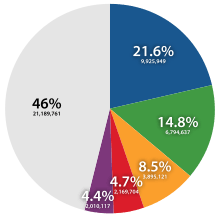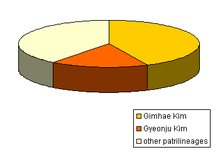Kim (Korean surname)
| Kim | |
|---|---|
| Family name | |
| Pronunciation | Kim, Gim |
| Meaning | Gold, iron |
| Region of origin | Korea |
| Language(s) of origin | Korean |
| Kim | |
| Hangul | 김 |
|---|---|
| Hanja | 金 |
| Revised Romanization | Gim |
| McCune–Reischauer | Kim |
Kim (occasionally romanized as Gim)[1] is the most common surname in the Korean Peninsula, accounting for nearly 22% of the population. Kim is written as "김" gim in Korean. ("김" solely by itself has no specific meaning unless specified by its underlying hanja or derived from context.) The hanja for Kim can also be transliterated as Hangul: 금 geum "metal, iron, gold".
Clans

Origin
Kims are descended from the Great Huns: north Asian people, including Mongols, Turks and Koreans. Linguists say that old Koreans are derived from the Hun which were called "Xiongnu" by the Chinese.
Prohibition of Intermarriage within Kim clans
Within the population that share the surname Kim, families are not immediately related to each other. These distinctions are important, since Korean law prohibits intermarriage in the same clan, no matter how remote the relationship; now, however, only those in a relationship of second cousins or closer are prohibited from marrying.
Distinction of Regions
As with other Korean surnames, the Kim clans are distinguished by the region of Korea from which they claim to originate. The 2000 South Korean census listed 348 extant Kim lineages.[2]
Uiseong
The Uiseong Kim (Hangul: 의성김씨 , hanja: 義城金氏 ) Clan traces its lineage back to the last prince of Silla, who later became a Monk. Kim Il-ji(김일지) was a prince of Hünnü/Huns/Xiongnu.
Andong
There are two Andong Kim clans (Hangul: 안동김씨; Hanja: 安東金氏) distinguished as Gu (Hangul: 구; Hanja: 舊) and Shin (Hangul: 신; Hanja: 新) that have 2 separate progenitors.
Some of the notable Gu Andong Kim clan members were General Kim Si-min and Prime Minister Kim Sa-hyeong, who was involved with the Gangnido map.
The Shin Andong Kim clan[3] was one of the powerful clans that dominated the later part of Joseon. One of the most powerful members from the clan was the Honorable Kim Josun, who was the father-in-law to Sunjo of Joseon. Kim Josun's daughter was Queen Sunwon.
Gimhae (Kimhae)
According to a story recorded only in the Samgungnyusa, in 48 CE, Princess Heo Hwang-ok travelled from a country called Ayuda to Korea, where she married Suro of Geumgwan Gaya and gave birth to ten children, thus starting the Kim dynasty of Geumgwan Gaya, the capital of which was in present-day Goryeong County.
Famous ancient members of this clan, aside from the kings of Geumgwan Gaya, include the Silla general Kim Yu-sin. In Later Silla, members of the Gimhae Kim family were admitted to all but the highest level of the Silla bone rank system.
This clan is by far the most populous of all Korean clans. The 2000 South Korean census found it to add up more than four million people.

Gyeong Seong
Gyeong Seong Kim (Hangul: 경성김씨 , Hanja:京城金氏) originated from Seoul in South Korea. This family living in Seoul of Korea separated from Gimhae in the 1910s.
Gyeongju
The Gyeongju Kims (Hangul: 경주김씨 , hanja: 慶州金氏 [4]) trace their descent from the ruling family of Silla. The founder of this clan is said to have been Kim Alji, an orphan adopted by King Talhae of Silla in the 1st century AD. Alji's seventh-generation descendant was the first member of the clan to take the throne, as King Michu of Silla in the year 262.
This clan is also extremely populous. In the South Korean census of 2000, more than 1.7 million citizens claimed to be Gyeongju Kims.
Nagan
The Nagan Kim clan (Hangul: 낙안김씨 , hanja: 樂安金氏 ) is extremely rare. Its progenitor, Kim Sujing (Hangul: 김수징 , hanja: 金粹澄 ), was a descendant of the last king of Silla and established their ancestral home in Suncheon. In the South Korean census of 2000, less than 10,000 citizens claimed to be Nagan Kims.
Hamchang
The Hamchang Kim (Hangul: 함창김씨 , hanja: 咸昌金氏 ) trace their origin to the founder of the little-known Gaya confederacy state of Goryeong Gaya, King Taejo. His alleged tomb, rediscovered in the sixteenth century, is still preserved by the modern-day members of the clan. This clan numbered only 26,300 members in the 2000 South Korean census.
Gwangsan
The Gwangsan Kim clan (Hangul: 광산김씨 , hanja: 光山金氏 [5]) was one of the most prominent clans during Joseon. The Gwangsan Kims are the descendants of Heung Gwang (흥광, 興光), who was the third prince of Sinmu of Silla, its 45th monarch.
Yaseong
Yaseong clan (Hangul: 야성김씨 , hanja: 野城金氏 ) is from Yeongdeok County. The name Yeongdoek replaced an earlier name, Yaseong, which means "City in the Wilderness" and dates its origins back to Silla.
Cheongpung
Cheongpung Kim clan (Hangul: 청풍김씨 , hanja: 淸風金氏 [6]) was one of the aristocratic families during the Joseon. Two queens were from this clan during that period. Several members of the clan also became prime ministers.
Yeonan
Yeonan Kim clan (Hangul: 연안김씨 , hanja: 延安金氏 ) was an aristocratic family clan that had members in high government positions during the Joseon. Six members of the clan were prime ministers.
Gangneung
Gangneung Kim clan (Hangul: 강릉김씨 , hanja: 江陵金氏 ) originated from Gangneung, Gangwon Province, South Korea. The progenitor was Kim Juwon (김주원, 金周元) who was a descendant of Muyeol of Silla.
Sangsan
Sangsan Kim clan (Hangul: 상산김씨 , hanja: 商山金氏 ) originated from Sangju in North Gyeongsang Province, South Korea. The progenitor was Kim Su (김수, 金需) and the clan had members that participated in the government of Joseon.
Ulsan
Ulsan Kim clan (Hangul: 울산김씨 , Hanja:蔚山金氏) originated from Ulsan in South Korea. One of the members of this clan, Kim Inhu, was one of the 18 Sages of Korea and honored as a Munmyo Bae-hyang, (문묘배향, 文廟配享).
Seoheung
Seoheung Kim clan (Hangul: 서흥김씨 , hanja: 瑞興金氏 ) was one of the smaller Kim clans during the Joseon. The progenitor was Kim Bo (김보, 金寶) and one of the members was Kim Gwoeng-pil (김굉필, 金宏弼), who was one of the 18 Sages of Korea and honored as Munmyo Bae-hyang, (문묘배향, 文廟配享).
Wonju
Wonju Kim clan (Hangul: 원주김씨 , hanja: 原州金氏 ) might be one of the smallest Kim clans during the Joseon. They had two members that became prime ministers during that period.
Other Kim clans
Gyeong Seoung Kim, 경성김씨 Ansan Kim clan, 안산김씨 Bu-an Kim clan, 부안김씨 Cheongdo Kim clan, 청도김씨 Cheongju Kim clan, 청주김씨 Eon-yang Kim clan, 언양김씨 Gaeseong Kim clan, 개성김씨 Geumsan Kim clan, 금산김씨 Gim-nyeong Kim clan, 김녕김씨 Gongju Kim clan, 공주김씨 Go-ryeong Kim clan, 고령김씨 Go-seong Kim clan, 고성김씨 Gwangju Kim clan, 광주김씨 Jeonju Kim clan, 전주김씨 Jinju Kim clan, 진주김씨 Naju Kim clan, 나주김씨 Pungcheon Kim clan, 풍천김씨 Pungsan Kim clan, 풍산김씨 Samcheok Kim clan, 삼척김씨 Seoha Kim clan, 서하김씨 Seonsan Kim clan, 선산김씨 Suncheon Kim clan, 순천김씨 Suwon Kim clan, 수원김씨 Ye-an Kim clan, 예안김씨 Yeongdong Kim clan, 영동김씨 (Yeongsan Kim clan, 영산김씨) Yeong-gwang Kim clan, 영광김씨
Notable people
See also
- Culture of Korea
- Korean name
- List of Korean family names
- Kim dynasty (North Korea)
- Jin, the equivalent Chinese surname
References
- ↑ In a study by the National Institute of the Korean Language based on 2007 application data for South Korean passports, it was found that 99.3% of people with this surname spelled it in Latin letters as Kim in their passports; only 0.6% spelled it as Gim. 성씨 로마자 표기 방안: 마련을 위한 토론회 [Plan for romanisation of surnames: a preparatory discussion]. National Institute of the Korean Language. 25 June 2009. p. 57. Retrieved 22 October 2015.
- ↑ "성씨, 본관별 가구 및 인구". Archived from the original on September 7, 2006. Retrieved 2006-10-04.
- ↑ 조선왕조실록, 정조 대왕 행장, Joseon Annals, King Jeongjo's life history record after death. c. 1800
- ↑ 조선왕조실록, Joseon Annals, Nov. 2, 1734, No. 2
- ↑ 조선왕조실록,순종실록부록,순종 18년8월21일. Joseon Annals, Aug. 21, 1925. No. 1
- ↑ 조선왕조실록, 정조 대왕 행장, Joseon Annals, King Jeongjo's life history record after death. c. 1800